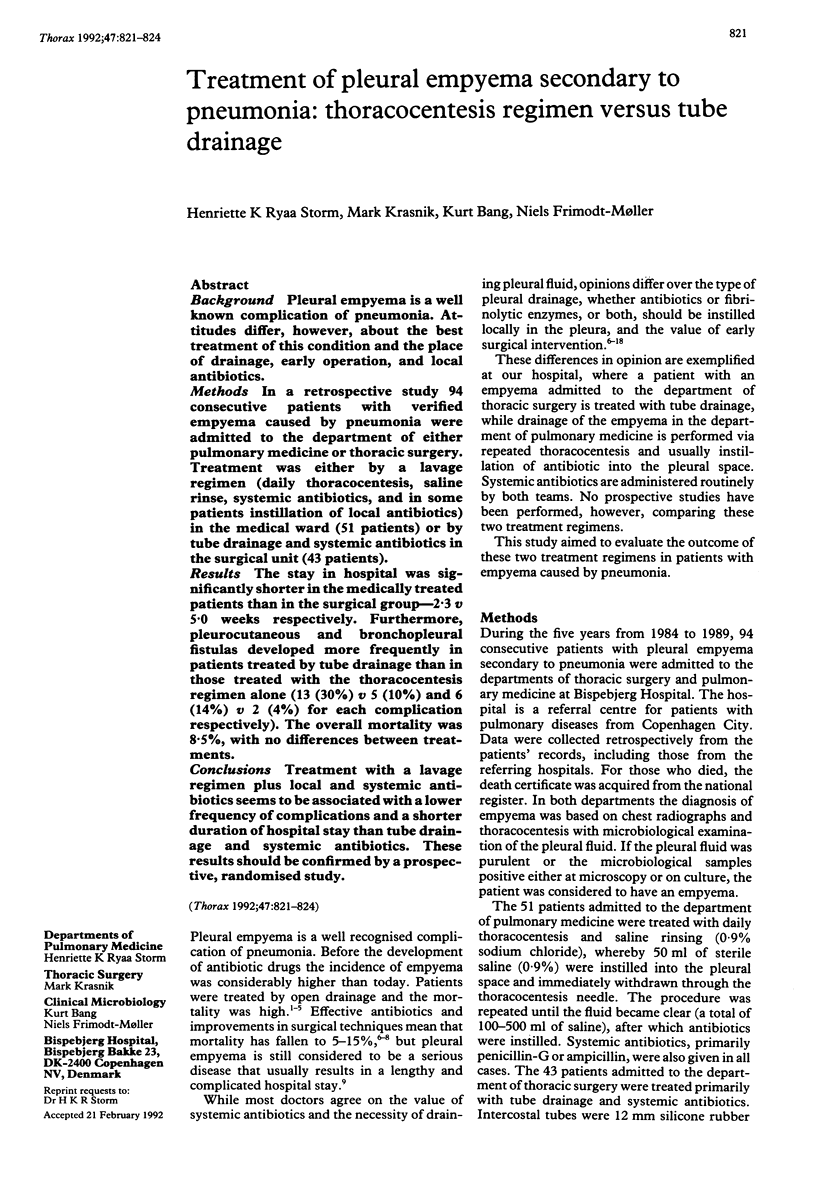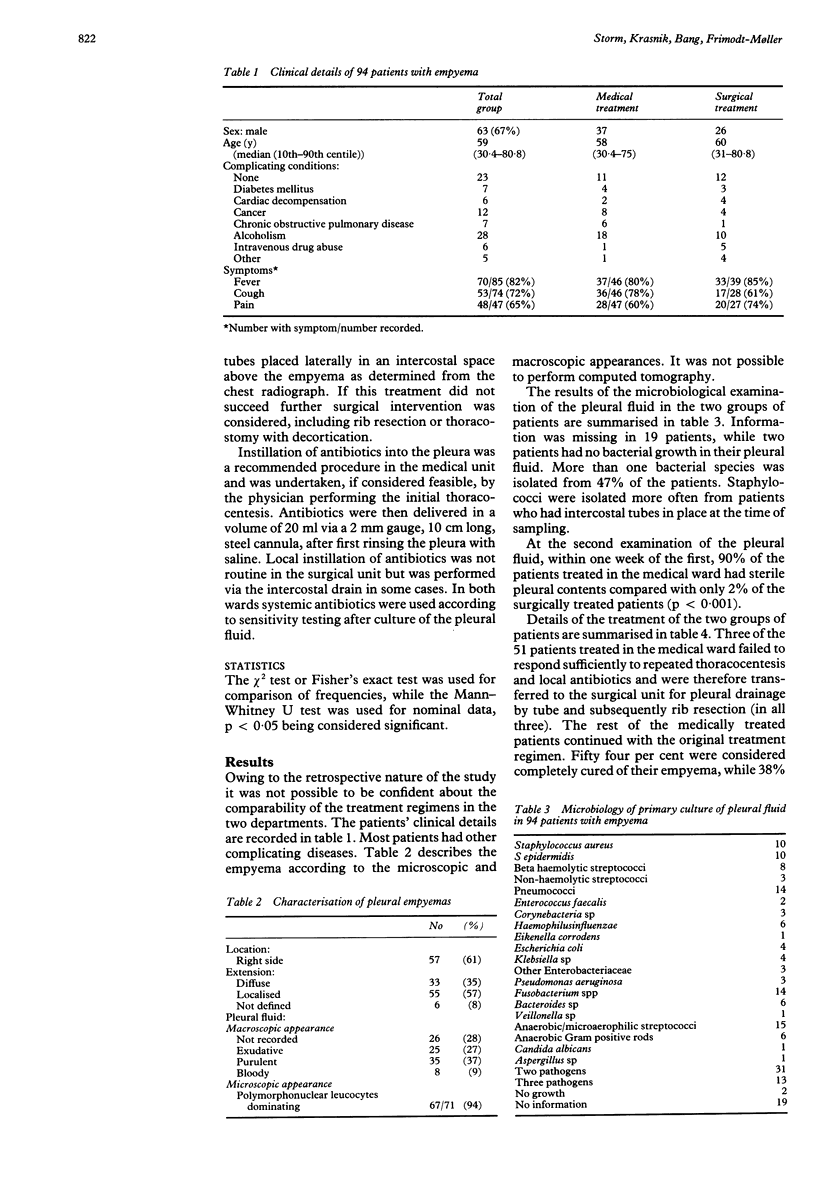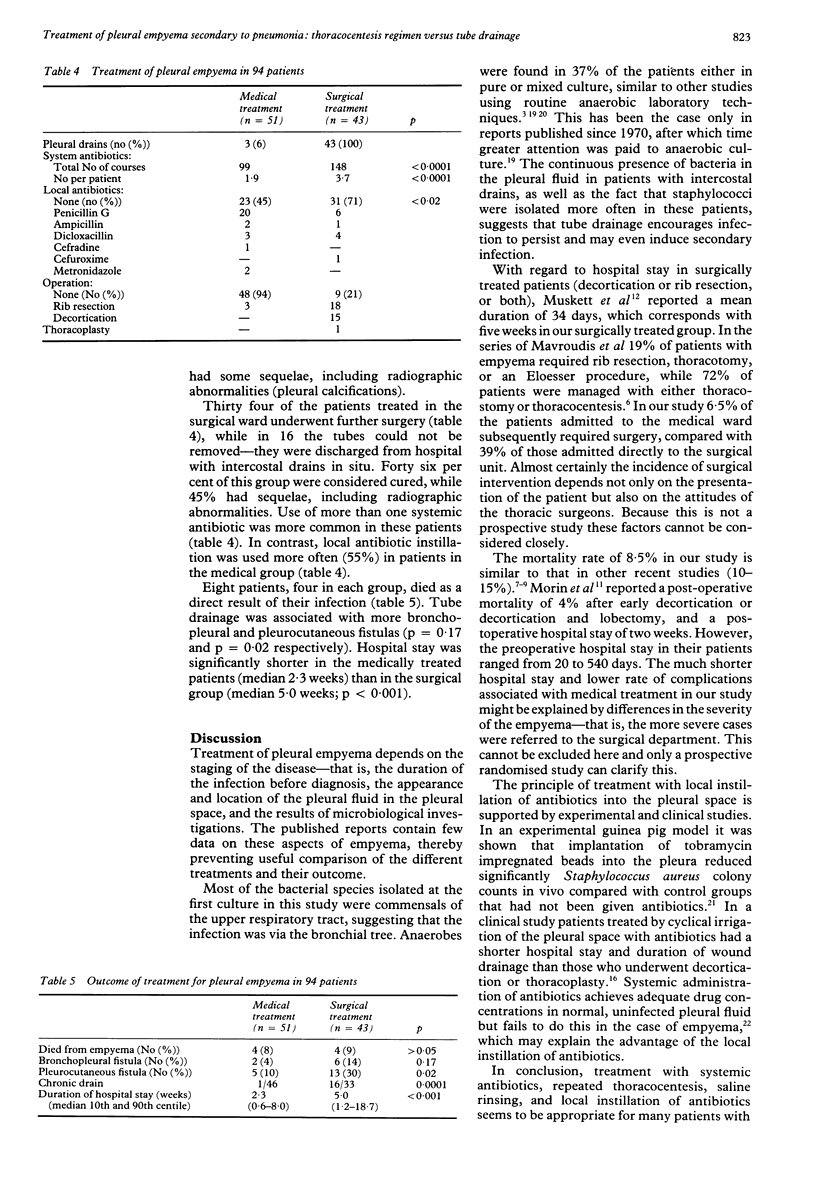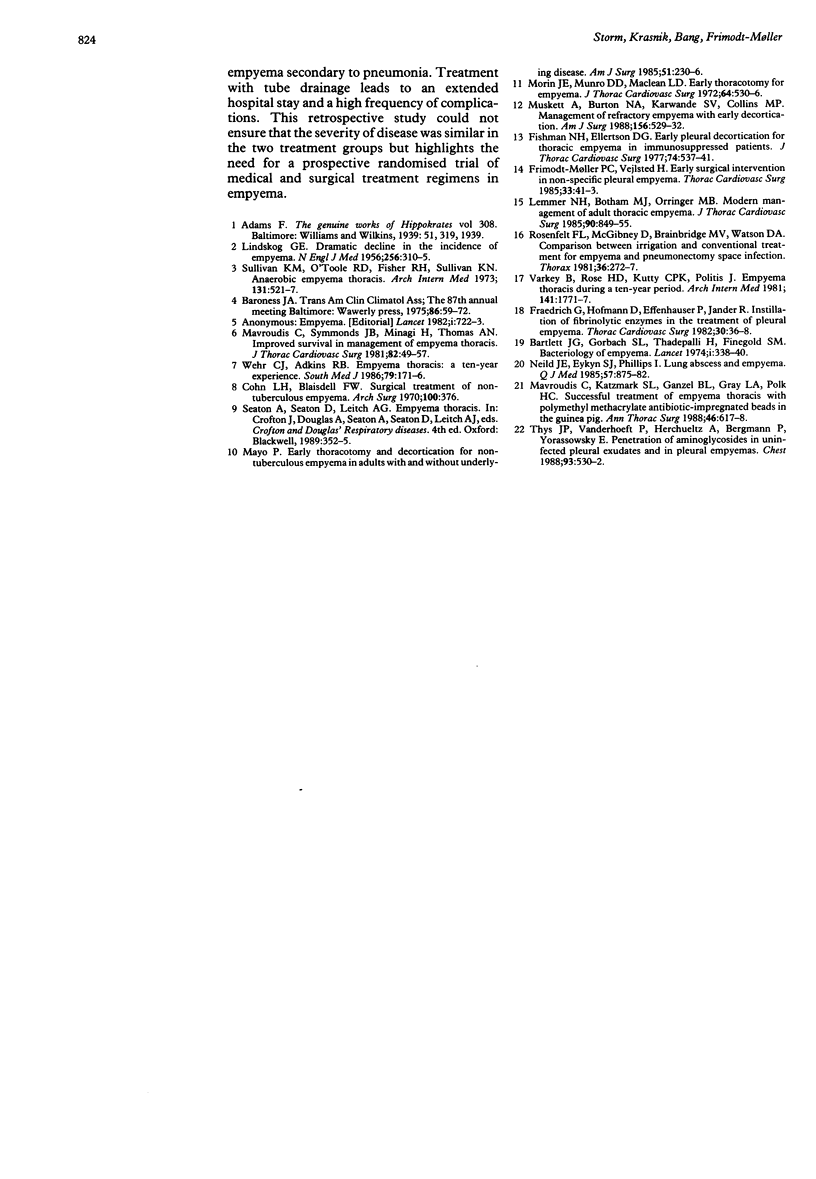Abstract
BACKGROUND: Pleural empyema is a well known complication of pneumonia. Attitudes differ, however, about the best treatment of this condition and the place of drainage, early operation, and local antibiotics. METHODS: In a retrospective study 94 consecutive patients with verified empyema caused by pneumonia were admitted to the department of either pulmonary medicine or thoracic surgery. Treatment was either by a lavage regimen (daily thoracocentesis, saline rinse, systemic antibiotics, and in some patients instillation of local antibiotics) in the medical ward (51 patients) or by tube drainage and systemic antibiotics in the surgical unit (43 patients). RESULTS: The stay in hospital was significantly shorter in the medically treated patients than in the surgical group--2.3 v 5.0 weeks respectively. Furthermore, pleurocutaneous and bronchopleural fistulas developed more frequently in patients treated by tube drainage than in those treated with the thoracocentesis regimen alone (13 (30%) v 5 (10%) and 6 (14%) v 2 (4%) for each complication respectively). The overall mortality was 8.5% with no differences between treatments. CONCLUSIONS: Treatment with a lavage regimen plus local and systemic antibiotics seems to be associated with a lower frequency of complications and a shorter duration of hospital stay than tube drainage and systemic antibiotics. These results should be confirmed by a prospective, randomised study.
Full text
PDF



Selected References
These references are in PubMed. This may not be the complete list of references from this article.
- Bartlett J. G., Gorbach S. L., Thadepalli H., Finegold S. M. Bacteriology of empyema. Lancet. 1974 Mar 2;1(7853):338–340. doi: 10.1016/s0140-6736(74)93079-7. [DOI] [PubMed] [Google Scholar]
- Cohn L. H., Blaisdell E. W. Surgical treatment of nontuberculous empyema. Arch Surg. 1970 Apr;100(4):376–381. doi: 10.1001/archsurg.1970.01340220052010. [DOI] [PubMed] [Google Scholar]
- Fishman N. H., Ellertson D. G. Early pleural decortication for thoracic empyema in immunosuppressed patients. J Thorac Cardiovasc Surg. 1977 Oct;74(4):537–541. [PubMed] [Google Scholar]
- Fraedrich G., Hofmann D., Effenhauser P., Jander R. Instillation of fibrinolytic enzymes in the treatment of pleural empyema. Thorac Cardiovasc Surg. 1982 Feb;30(1):36–38. doi: 10.1055/s-2007-1022203. [DOI] [PubMed] [Google Scholar]
- Frimodt-Møller P. C., Vejlsted H. Early surgical intervention in non-specific pleural empyema. Thorac Cardiovasc Surg. 1985 Feb;33(1):41–43. doi: 10.1055/s-2007-1014081. [DOI] [PubMed] [Google Scholar]
- Lemmer J. H., Botham M. J., Orringer M. B. Modern management of adult thoracic empyema. J Thorac Cardiovasc Surg. 1985 Dec;90(6):849–855. [PubMed] [Google Scholar]
- Mavroudis C., Symmonds J. B., Minagi H., Thomas A. N. Improved survival in management of empyema thoracis. J Thorac Cardiovasc Surg. 1981 Jul;82(1):49–57. [PubMed] [Google Scholar]
- Mayo P. Early thoracotomy and decortication for nontuberculous empyema in adults with and without underlying disease. A twenty-five year review. Am Surg. 1985 Apr;51(4):230–236. [PubMed] [Google Scholar]
- Morin J. E., Munro D. D., MacLean L. D. Early thoracotomy for empyema. J Thorac Cardiovasc Surg. 1972 Oct;64(4):530–536. [PubMed] [Google Scholar]
- Muskett A., Burton N. A., Karwande S. V., Collins M. P. Management of refractory empyema with early decortication. Am J Surg. 1988 Dec;156(6):529–532. doi: 10.1016/s0002-9610(88)80546-4. [DOI] [PubMed] [Google Scholar]
- Neild J. E., Eykyn S. J., Phillips I. Lung abscess and empyema. Q J Med. 1985 Dec;57(224):875–882. [PubMed] [Google Scholar]
- Rosenfeldt F. L., McGibney D., Braimbridge M. V., Watson D. A. Comparison between irrigation and conventional treatment for empyema and pneumonectomy space infection. Thorax. 1981 Apr;36(4):272–277. doi: 10.1136/thx.36.4.272. [DOI] [PMC free article] [PubMed] [Google Scholar]
- Sullivan K. M., O'Toole R. D., Fisher R. H., Sullivan K. N. Anaerobic empyema thoracis. The role of anaerobes in 226 cases of culture-proven empyemas. Arch Intern Med. 1973 Apr;131(4):521–527. doi: 10.1001/archinte.131.4.521. [DOI] [PubMed] [Google Scholar]
- Thys J. P., Vanderhoeft P., Herchuelz A., Bergmann P., Yourassowsky E. Penetration of aminoglycosides in uninfected pleural exudates and in pleural empyemas. Chest. 1988 Mar;93(3):530–532. doi: 10.1378/chest.93.3.530. [DOI] [PubMed] [Google Scholar]
- Varkey B., Rose H. D., Kutty C. P., Politis J. Empyema thoracis during a ten-year period. Analysis of 72 cases and comparison to a previous study (1952 to 1967). Arch Intern Med. 1981 Dec;141(13):1771–1776. doi: 10.1001/archinte.141.13.1771. [DOI] [PubMed] [Google Scholar]
- Wehr C. J., Adkins R. B., Jr Empyema thoracis: a ten-year experience. South Med J. 1986 Feb;79(2):171–176. doi: 10.1097/00007611-198602000-00009. [DOI] [PubMed] [Google Scholar]


